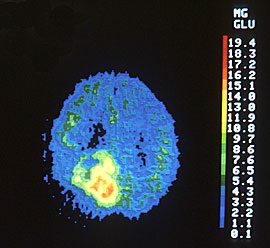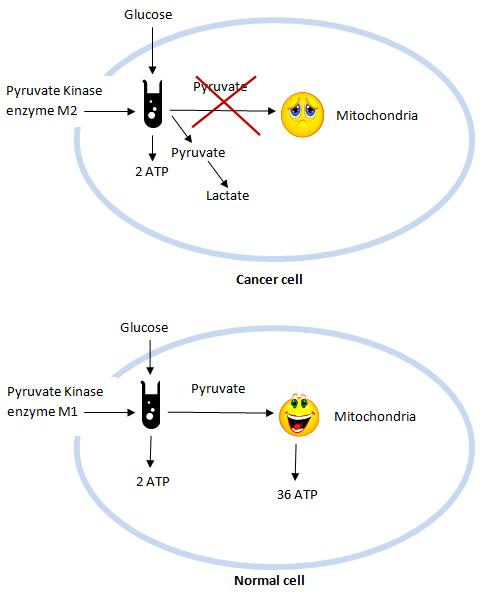The internet is a wonderful thing, information really
becomes
available at our fingertips. Like everything, with the good comes the
bad and, when we speak of cancer, a lot of bad information is
unfortunately published. Everybody seems to have his/her own
interpretation of the Warburg theory. In this document I'll
try to clarify what this theory is and what we know about
cancer cell metabolism.
The Warburg Effect
In 1931 Otto Heinrich Warburg was attributed the
Nobel price in Physiology and Medicine mainly for his
investigation of the metabolism of tumours and the
respiration of cells, and more
particularly for his discovery of the nature and mode of
action of respiratory enzymes. He edited and has much of his
original work published in The
Metabolism of Tumours
(tr. 1931) and wrote New Methods of Cell Physiology
(1962).
Otto Warburg observed that cancer cells' metabolism is different
than the one of normal
adult cells. Normal adult cells use a small energy plant
located inside them to produce most of their energy needs from
oxygen, this is an aerobic process. In contrast, cancer
cells rely mainly on the first part of the energy production
process dependant on glucose (sugar), this is an anaerobic
process. The anaerobic process is called
glycolysis.
The paradox is that cancer cells rely on glycolysis
even if oxygen is available. This phenomenon is called
aerobic glycolysis or the
Warburg effect.
Many decades later, this observation was exploited by
clinicians to better visualize tumours using PET (positron
emission technology) imaging. But it has not been known
exactly how tumour cells perform this alternate metabolic
feat, nor was it known if this process was essential for
tumour growth. Now,
two papers appearing in the March 13 (2008) issue of the
journal Nature help answer these questions. Led by
researchers at Beth Israel Deaconess Medical Centre (BIDMC)
and Harvard Medical School, the papers find that the
metabolic process that has come to be known as the Warburg
effect is essential for tumours' rapid growth, and
identifies the M2 form of pyruvate kinase (PKM2), an enzyme
involved in sugar metabolism, as an important mechanism
behind this process.
The "Warburg Effect" is a unique property of most cancers.
The phenomenon is characterized by increased glucose uptake
and reliance on glycolysis for ATP production despite
available oxygen source.
Cancer Cell Metabolism

In the above figure, the yellow coloured part is named
cytosol, this is where the energy production process starts.
At first, glucose molecules are percolating into the cell through
the cell membrane by diffusion. You can imagine the glucose
molecule in the yellow part of the cell: the cytosol. It
doesn't stay free very long, it becomes engaged in a
biochemical process to produce what the cells like the best
(their favourite food), ATP. This process
occurring in the cytosol is named glycolysis.
It is not very efficient, only two servings (2
molecules) of ATP are available for all cell metabolism
needs. Usually, to satisfy the huge appetite of normal
cells, little power plants also nicknamed Mitochondria take
a by-product of glycolysis, pyruvate, and convert
it into 36
servings!! To accomplish such miracle, mitochondria use
oxygen.

What Otto Warburg discovered is that most cancer cells rely only
on the first part of the energy process: glycolysis. They
use glucose to produce their cell food (ATP). Their
mitochondria are not involved in the cell food production
process. Because they rely on glycolysis which is a less
efficient mean of production (only 2 servings of ATP), they
need more glucose to satisfy their enormous appetite.
Compared to normal cells which can, from a single molecule
of glucose, produce 36 to 38 servings of ATP, cancer cells
will need 19 molecules of glucose to produce an equivalent
quantity (38 ATP = 2 ATP X 19 glucose). From these numbers
we can see that cancer cells will BE huge consumers of glucose
to satisfy their sugar crave. This is why some medical
imaging techniques can help us locate tumours when they
reach a certain size. Radio-active glucose is injected in
patients. The Positron Emission Tomography (PET) scan tool
is sensible to radio-active material. Since cancer cell will
consume 18 to 19 times more glucose than normal cells, they
will accumulate more radio-active material as illustrated in
the picture below.
 |
Shown in the left is a Positron Emission Tomography
(PET) scan of a 62 year old man with a brain tumour.
The irregular bright yellow and orange area in the
lower left portion of the brain indicates the
location of the tumour, which metabolizes glucose
faster than normal cells. |
The Role of Enzymes in Glycolysis

|
The aerobic glycolysis or the Warburg effect, is thought to
be due to the reprogramming of metabolic genes to allow
cancer cells to function more like fetal cells and to enable
a greater fraction of glucose metabolites to be incorporated
into macromolecules synthesis rather than burned to CO2. In
other words, glucose is used more for replication than for
normal cell metabolism.
Recent research demonstrated that one
enzyme makes the whole difference: Pyruvate
Kinase. It is an enzyme involved in the last
step of the glycolysis process.
Pyruvate kinase exists in two
different versions: M1 and M2. The M1 isoform is expressed
in most adult tissues; and the M2 isoform is a slice variant
of M1 expressed during embryonic development(1).
It has been
reported that tumour tissues exclusively express the
embryonic M2 isoform of pyruvate kinase(2,3,4).
|
Given that pyruvate kinase M2 is expressed during
embryonic development and in many non-transformed cell
lines, M2 expression alone is unlikely to be a transforming
event Rather, the presence of of PKM2, may contribute to a
metabolism environment that is amenable to cell
proliferation.
At the end of the glycolysis process, the enzyme pyruvate
kinase help in the final production of two molecules of ATP
and one molecule of pyruvate. The pyruvate molecule is then
passed to the mitochondria to be transformed into 36
molecules of ATP.
A gatekeeper stands at the front of the mitochondria, it is
a mitochondrial
enzyme, the pyruvate dehydrogenase (PDH). Without
the
latter, the pyruvate produced by the glycolysis cannot gets
into the highly efficient mitochondria power plant.

Writing Notes:
I need to review the document to edit
and most probably add new content. I should get more info on
DCA. There is a growing evidence that DCA is very potent for
several cancer cases. I saw more and more well documented
remission reports in the last months. I should add more
content about why glycolysis can contribute to cancer cell
proliferation and why some molecules like DCA bring back the
natural life cycle. I also need to add several sections
about the different stages of tumourigenesis. Barry said
that I need to add some content on why active mitochondria
lead to apoptosis because this is the DCA active pathway. I
think he is right.
references
(1) Jurica M.S et al. The allosteric regulation of
pyruvate kinase by fructose-1,6-bisphosphate, Structure 6,
195-210 (1998)
(2) KHeather R. Christofk et al. The M2 slice isoform of
pyruvate kinase is important for cancer metabolism and
tumour growth. Nature vol. 452|13 March 2008.
(3) Mazurek et al. Pyruvate kinase type M2 and its role in
tumour growth and spreading. Semin. Cancer biol. 15, 300-308
(2005)
(4) Dombrauckas et al. Structural basis for tumor pyruvate
kinase M2 allosteric regulation and catalysis. Biochemistry
44, 9417-9429 (2005).
